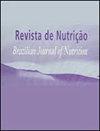Prevalence of prediabetes in adults and its association with sociodemographic, nutritional, metabolic and mental disorders factors: Home Health Survey, Piauí, Brazil.
IF 0.5
4区 医学
Q4 NUTRITION & DIETETICS
Revista De Nutricao-brazilian Journal of Nutrition
Pub Date : 2022-01-01
DOI:10.1590/1678-9865202235e220046
引用次数: 0
Abstract
ABSTRACT Objective To estimate prevalence of prediabetes and to investigate its associated factors in adults living in Teresina, Piauí, Brazil Methods Cross-sectional, home-based study, with both genders adults in Teresina, Piauí. The prevalence of prediabetes was estimated using the fasting glucose test, and was classified according to the American Diabetes Association standards (≥100mg/dL; <126mg/dL). The associations between prediabetes and the variables: sociodemographic, anthropometric, food consumption, blood pressure levels, triglycerides and common mental disorders were tested. In addition, a variable was created to verify the association of the simultaneous presence of risk factors in the same individual. Data were reviewed using Pearson’s chi-square test and Poisson regression for crude and adjusted prevalence ratios, considering a significance level of 5%. Results A total of 224 adults participated in the study, of which 154 (68.7%) were female, aged between 20 and 39 years (53.1%). An 8.04% prevalence of prediabetes was observed. A statistically significant association (p<0.05) was found between lower education (0 to 8 years of study; 17.3%) and increased triglycerides levels (≥150mg/dL; 13.7%). Higher gross prevalence (PR: 2.53; CI 95%: 1.05-6.05) prediabetes ratios were observed with 5 or more simultaneous risk factors when compared to individuals who had up to 4 simultaneous risk factors. Conclusion Low schooling, hypertriglyceridemia and the presence of five or more simultaneous risk factors were associated with prediabetes; however, these risk factors are subject to intervention. Therefore, this study points to the need for changes in lifestyle habits as a strategy for glycemic control and diabetes prevention.成人糖尿病前期患病率及其与社会人口学、营养、代谢和精神障碍因素的关系:家庭健康调查,Piauí,巴西。
【摘要】目的评估巴西Teresina (Piauí)地区成人糖尿病前期患病率,并探讨其相关因素。方法对Teresina (Piauí)地区男女成人进行横断面家庭研究。使用空腹血糖试验估计糖尿病前期患病率,并根据美国糖尿病协会标准(≥100mg/dL;< 126 mg / dL)。研究人员测试了糖尿病前期与以下变量之间的关系:社会人口统计学、人体测量学、食物消耗、血压水平、甘油三酯和常见精神障碍。此外,还创建了一个变量来验证同一个体中同时存在的风险因素之间的关联。采用Pearson卡方检验和泊松回归对粗患病率和校正患病率进行分析,考虑显著性水平为5%。结果共224名成人参与研究,其中女性154人(68.7%),年龄在20 ~ 39岁之间(53.1%)。糖尿病前期患病率为8.04%。受教育程度较低(0 ~ 8年);17.3%)和甘油三酯水平升高(≥150mg/dL;13.7%)。较高的总患病率(PR: 2.53;CI 95%: 1.05-6.05)与同时有4个危险因素的个体相比,观察到有5个或更多危险因素的糖尿病前期比率。结论低学历率、高甘油三酯血症及同时存在5种及以上危险因素与糖尿病前期相关;然而,这些危险因素是需要干预的。因此,这项研究指出,需要改变生活习惯,作为控制血糖和预防糖尿病的策略。
本文章由计算机程序翻译,如有差异,请以英文原文为准。
求助全文
约1分钟内获得全文
求助全文
来源期刊
CiteScore
1.20
自引率
12.50%
发文量
24
审稿时长
6-12 weeks
期刊介绍:
Revista de Nutrição is former Revista de Nutrição da Puccamp, founded in 1988. It is a bimonthly publication every four months and it is of responsibility of the Centro de Ciências da Vida, da Pontifícia Universidade Católica de Campinas . It publishes articles that contribute to the study of Nutrition in its many sub-areas and interfaces; and is open to contributions of the national and international scientific communities.

 求助内容:
求助内容: 应助结果提醒方式:
应助结果提醒方式:


